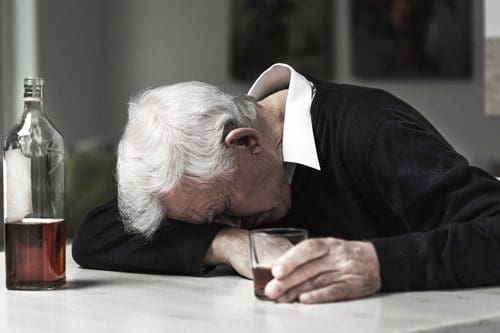When you think of binge drinking, who comes into your mind?
A college student drinking excessively on the weekend? A young person having too much to drink at a party? It may surprise you to learn that most binge drinkers fall into the age range of 26 and older. In fact, many senior citizens, aged 65 and above, also binge drink.
What Is Binge Drinking?
When an individual drinks an excessive amount of alcohol in a single session over a short period of time, they are binge drinking. The National Institute on Alcohol Abuse and Alcoholism defines binge drinking as “a pattern of drinking that brings a person’s blood alcohol concentration (BAC) to 0.08 (g/dl) or above.”
Typically, this occurs when women consume four or more drinks in a two-hour time span or men consume five or more drinks in the same time span. For adults aged 60 and above, binge drinking is defined for men as having no more than three drinks per day and for women as having no more than two drinks per day.
A drink is classified as the following:
- One 5-ounce glass of wine
- One 12-ounce glass of beer
- One 1.5-ounce shot of distilled spirits, which includes all unsweetened liquors and sweetened liqueurs
In the United States, binge drinking is one of the most common patterns of alcohol use.
Binge Drinking Facts and Statistics
A study conducted in 2015 by the Centers for Disease Control and Prevention (CDC) found that in the United States one in six adults, or 36 million people, reported binge drinking. Each person binged about four times a month, drinking an average of seven drinks each time. This totals approximately 17 billion drinks a year, or about 467 drinks per binge drinker. The study also found that men binge drink twice as often as women, with four out of every five drinks being consumed by men.
The following additional facts are from the Substance Abuse and Mental Health Services Administration (SAMHSA):
- Teenagers who binge drink are three times more likely to develop an alcohol related disorder as an adult than those who do not binge drink. The earlier they start drinking, the greater the risk is.
- Younger binge drinkers are more likely to drink in another person’s home with their friends.
- Statistics for younger individuals show seasonal fluctuations in their binge drinking, with an increase during exam times and social occasions, such as sporting events, homecoming, and proms.
- 37.9 percent of college students reported binge drinking.
- Approximately 2,000 college students die every year from alcohol-related injuries.
- Approximately 700,000 students are assaulted by another student who has been drinking.
Reasons for Binge Drinking
Each year the number of binge drinkers continues to rise. Many teenagers and young adults want to be seen as their own person. Some use binge drinking as a way to resist social norms and rules, while others drink to assert their independence and boost their confidence. For older individuals, common reasons for binge drinking include:
- Forgetting problems – A very common reason people of all ages give for binge drinking is to forget about their underlying problems, relax, and loosen up.
- Having fun – Many social activities and events involve alcohol, especially when an individual’s social circle is comprised of heavy drinkers.
- A tolerance test – Drinking alcohol often turns into a competition when people try to outdrink one another in drinking games.
Side Effects of Binge Drinking
The side effects of binge drinking generally depend on several factors:
- The amount of alcohol you consume
- How quickly you drink
- Your gender
- Your weight
- Whether other drugs are involved and if they were which drugs, how much was taken, and when they were taken
- Your medical history
Short-Term Side Effects of Binge Drinking
Some side effects of binge drinking are minor and temporary, while others can cause permanent damage. For example, your reaction time is delayed by drinking alcohol—which puts you, other drivers, and pedestrians in danger if you decide to drive. Also, excessive drinking impairs judgment—putting you at risk for possible unintentional injuries from domestic violence, sexual assault, or falls.
Sudden temporary side effects include:
- Memory loss
- Total or partial blackout
- Poor judgment and decision making
- Nausea and/or vomiting
- Dehydration
- Shakiness
- Engaging in risky or dangerous behaviors
If enough alcohol is consumed, fatal alcohol poisoning can occur.
Long-Term Side Effects
All of the body’s organs and systems are affected by long-term binge drinking. For example, possible cardiovascular problems include hypertension, stroke, an irregular heartbeat, or a sudden heart attack that can cause death.
Several additional harmful long-term side effects of binge drinking include:
- Brain damage causing long-term memory loss or learning problems
- Liver damage
- Cancer
- Depression
- Infertility
- Alcohol dependence
Binge drinking can also lead to an array of other problems including car accidents, unemployment, sexually transmitted diseases or infections, or domestic violence. For women, unplanned pregnancy can occur—often resulting in poor outcomes such as miscarriages, stillbirth, or fetal alcohol spectrum disorders.
Getting Help
Although engaging in binge drinking doesn’t automatically mean someone has a substance abuse problem, this behavior is a definite warning sign. If you or a loved one are struggling with alcohol addiction, help is available. Canyon Vista Recovery Center provides a full continuum of care for men and women diagnosed with alcohol use disorders.





